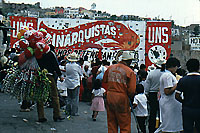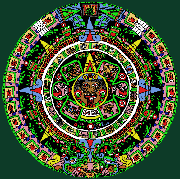THE
ROLLERCOASTER RIDE OF MEXICAN POLITICS
by
Bob Brooke

Like
many countries during their development, Mexico has had its share of
political ups and down, even though it’s a multi-party democracy.
Mexican politics has been notorious for election fraud–something that
is happily beginning to change--ever since it adopted a republican
government in 1917.
The general election held
on July 2nd, 2000, became a climactic point in the democratic advance in
Mexico. For the first time in 71 years, the major opposition party, the
National Action Party (PAN), defeated the ruling party, the
Institutional Revolutionary Party (PRI), at the ballot boxes, electing
its candidate, President Vincente Fox Quesada, as president, an event
which reflects the democratic advancement of the country.
Up to the end of former
President Ernesto Zedillo’s term, high political offices seemed to be
part of a ruling dynasty extending outward from the presidency since the
PRI president in power chose his successor to run against the then
weaker PAN party candidate. But that’s all come to an end now that the
weaker party is the stronger one.
Even so, there’s still
a chain of command reaching from local mayors all the way to the
Presidency. Presidentes municipales appoint city delegados to represent
the federal government at the local level. The President appoints
subdelegados to smaller towns and villages. Both types of
representatives have full federal power within their jurisdictions.
Unlike Presidents of the
United States, the Mexican Constitution limits Mexican presidents to a
single six-year term known as el sexenio. His powers are similar
to those held by U.S. presidents.
The Beginning of
Mexican Politics
General Antonio Lopez de Santa Ana, took control of Mexican politics
from 1833 to 1855. Santa Ana was Mexico's leader during the conflict
with Texas. The French invasion and the imposition of a second monarch,
led by Archduke Maxmillian of Austria in 1864 interrupted the
presidential term of Benito Juarez. Maximilian, whom Napoleon III of
France established as Emperor of Mexico, was deposed by Juarez and
executed in 1867, restoring the republic's regime.
Between 1877 and 1911,
General Porfirio Diaz was President of Mexico. Mexico's severe social
and economic problems erupted in a revolution that lasted from 1910 to
1920 and gave rise to the Constitution of 1917. Prominent leaders in
this period--some of whom were rivals for power--were Francisco I.
Madero, Venustiano Carranza, Pancho Villa, Alvaro Obregon, Victoriano
Huerta, and Emiliano Zapata.
In 1929, General Plutarco
Calles founded the political party that would be the predecessor of the
Institutional Revolutionary Party (PRI), The PRI emerged as a coalition
of interests after the chaos of the Revolution as a vehicle for keeping
political competition peaceful. General Lazaro Cardenas del Rffo,
who nationalized the petroleum industry of the country, held the office
of president from 1934 to 1940. During this presidential period, Manuel
Gomez Moron founded the National Action Party in 1939.
In 1968 the Mexican
government violently repressed a social movement on the eve of the
Olympic Games. And in 1988, amidst accusations of fraud, the political
party PRI almost lost the general elections.
NAFTA
On the first day of 1994, the National Free Trade Agreement with the
U.S. and Canada went into effect. But unexpected and traumatic events
threw the country into political upheaval. Peasants from the southern
state of Chiapas briefly took up arms against the government, protesting
alleged oppression and governmental indifference to poverty. After
nearly two weeks of fighting, a cease-fire halted clashes. Since then,
the government and the Zapatista Army of National Liberation (EZLN) have
negotiated on topics such as granting greater autonomy to indigenous
people.
In March 1994, gunmen
assassinated PRI presidential candidate Luis Donaldo Colosio as he left
a political rally in Tijuana. In September 1994, other gunmen
assassinated PRI Secretary General Jose Francisco Ruiz Massieu. Although
the government tried and convicted the gunmen in both murders and
co-conspirators in the Ruiz Massieu murder, the Mexican public hasn’t
been satisfied that all the truth behind these crimes has been
uncovered.
In the general elections
of that year, Dr. Ernesto Zedillo Ponce de Leon, candidate of the PRI
for the presidency, won the elections. President Ernesto Zedillo
continued the process already underway of opening Mexico's political
system, reforming the justice system, curtailing corruption,
strengthening the fight against narcotics trafficking, and furthering
Mexico's market-oriented economic policies. A severe financial crisis
occupied much of the Zedillo administration's attention in 1995 and
1996, creating a need for difficult emergency economic stabilization
policies and intensified longer-term economic restructuring.
1
2
next
page-> |

